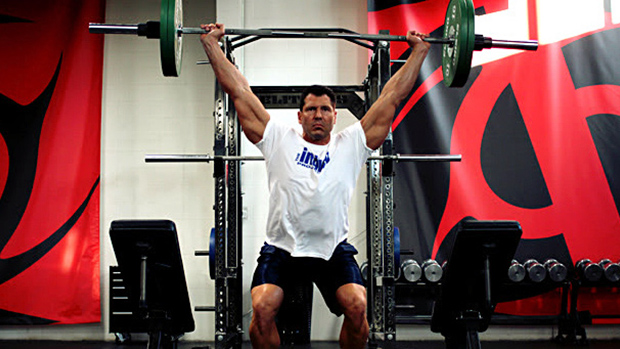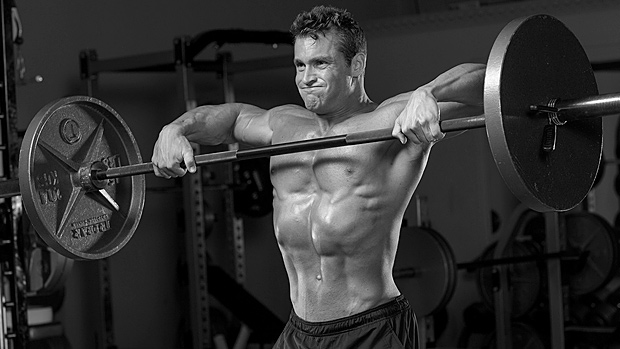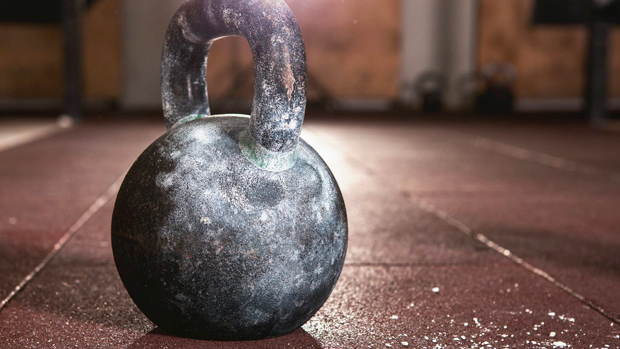Let's play T-mag Jeopardy.
Answer: The most successful strength and conditioning programs have this in common.
Question: What are power cleans, Alex?
Yep, it's true. The power clean has been in the arsenal of the most successful strength and conditioning programs in America for quite some time now. The football programs of Nebraska, Florida, WSU, Texas and Tennessee have pioneered the use of the power clean and are renowned for producing some of the strongest and most powerful athletes year after year. Not only that, the power clean is an important staple in the training of virtually all track-and-field athletes.
In fact, the power clean is often regarded as a "miracle" exercise. It's touted as being the best way to develop applicable power and strength for most sports, especially power dependant sports such as football, basketball, rugby, track and field, and volleyball, among others.
I'm an Olympic weightlifter and an Olympic lifting coach, but believe it or not, I don't think the power clean is the best exercise to develop strength and power (power being regarded as explosive strength or speed-strength). That's right! I believe there's a superior exercise that blows away the power clean: the power snatch.
The power snatch is a close relative to the power clean and both are derived from the competitive Olympic lifts like the snatch and clean & jerk. Structurally, both exercises are similar to one another with one major difference: in the power clean you lift the bar from the ground to your shoulders; in the power snatch you lift the bar from the floor to over your head in one single movement.
Obviously, the power snatch requires a greater explosion because you must create more momentum for the bar to be successfully flung overhead. There's also less room for arm and lower back pull in the power snatch. Sometimes an individual will execute a power clean that has much more in common with a reverse curl done with lots of cheating than to an explosive Olympic lift!
In the snatch, relying on arm pull and back hyperextension will result in a missed lift most of the time. To be successful with the power snatch you really must emphasize hip and leg drive, which are more specific to most sports.
Here's a diagram of power snatch sequence:

Power snatch sequence, Thibaudeau 2001
Let's break down the key points:
Step One (Starting Position)
a) Shoulders above or just forward of the bar
b) Arms loose and extended
c) Traps stretched
d) Back arched and tight, chest pointing forward
e) Toes directly under the bar
f) Quads approximately parallel to the ground
g)
in front of you
Step Two
a) Bar is lifted only with the legs at this point
b) Angle of the back remains the same
c) Arms still fully extended and loose
d) Traps still stretched
e) Chest still pointing forward
f) Shoulders are kept forward of the bar
Step Three
a) Torso starts to straighten
b) Legs continue to extend
c) Bar is kept very close to the body (a slight grazing of the body is okay)
d) Shoulders are above the bar
Step Four
a) There's a re-bending of the knees (more or less depending on the lifter)
b) Torso straightens
Step Five and Six
a) Powerful explosion upward (not backward!)
b) Legs fully extend
c) Traps contract forcefully
d) Basically the lifter tries to "jump up"
e) Bar is kept close to the body
f) Arms bend somewhat, but that's because of the momentum of the bar, not arm pull
Step Seven
a) Lifter squats just low enough to catch the bar overhead with arms fully locked
b) Traps and shoulders contract to stabilize bar
Step Eight
a) Once the bar is stable, the lifter stands up and the lift is completed
Step Nine (Optional)
Look around for the guy you saw earlier curling in the squat rack. When he gets close, see if you can drop the bar on his toes. Then go talk to aforementioned vixen.
Why I Like a Powerful Snatch
What are the benefits of the power snatch over the power clean? Most importantly, it's just really fun to say the word snatch in public and make crude jokes. You just can't beat that, can you? Seriously, besides the greater involvement of the legs and hips, there are many advantages to the power snatch:
• There's a greater power output during the power snatch because lighter weights and more explosion (acceleration) are used. Why does the power snatch have a greater power output than the power clean? Well, power is generally considered to be the rate of work and can be expressed with any of these formulas:
P = W / Time
(Power = Work / Time or the amount of work per unit of time)
P = Fd / Time
(Power = Force x Distance / Time. Force x Distance is equivalent to the work performed)
P = FV
(Power = Force x Velocity)
Regardless of the formula used (they're all derivatives of each other), we can say that power output can be influenced by the force output (F = MA), the velocity of the movement, and the distance traveled by the bar.
In the power snatch the velocity is greater than in the power clean and the bar has to go through a greater distance. As for the force output, I'd say there isn't a significant difference between the power clean and the power snatch. The power snatch requires more acceleration (greater "A" factor in the F = MA formula) and the power clean allows you to use a greater load (greater "M" factor).
As a rule of the thumb we could say the power clean allows for a greater load (around 20%) compared to the power snatch, while the power snatch requires similarly greater acceleration. So for a sport where explosion, acceleration and speed is needed, the power snatch is a superior exercise.
Here's a quick rundown of the advantages of the power snatch:
• The power snatch requires greater control of an object moving in space.
• The power snatch is the safest of the Olympic lifts because of the lighter load used, thus less stress on the tendons and ligaments.
• The power snatch requires more coordination than the power clean, so introducing the power clean first isn't a bad idea. It also develops coordination better than most other exercises.
• The power snatch really relies on the full triple extension (ankles, knees, hips) which has a great transfer to many athletic movements.
• The power snatch builds confidence for the power clean and the jerk.
• The power snatch is probably the most motivating exercise to do. When done right it feels effortless, not to mention that it's very satisfying to lift a load straight over your head.
Conclusion
I'd strongly recommend that the power snatch be part of any good strength program. It's one of the best ways to develop the capacity to generate power, it's the safest of the Olympic lifts, and it's the most fun and motivating one to do!
Don't get me wrong, though. I don't recommend dropping the power clean in favor of the power snatch. Far from it! The power clean remains a fantastic strength and power builder. However, including both the power snatch and the power clean in a training program will definitely improve athletic ability.
Just keep in mind that the athlete's objective for the power snatch (and the Olympic lifts in general) is an increase in power output. For that reason, maximum loads shouldn't be attempted. The acceleration reached, not the load used, should be the main marker of improvement.
As such, a load of 75 to 85% of 1RM for three to six reps is ideal for most athletes. Increase the amount of weight only if acceleration and proper technique can be maintained for the whole set. This will help you build a healthier and more powerful body.
And you'll get to say snatch a lot in public without getting your face slapped.
Need to know more?
Here's a recommended reading list:
To help you better understand and coach Olympic lifting technique:
Zhekov IP and others, Weightlifting Training and Technique, Livonia Michigan, Sportivny Press, 1992
Roman RA., The Training of the Weightlifter 2nd ed., Livonia michigan, Sportivny Press, 1988.
Drechsler A., The Weightlifting Encyclopedia, A is A Communication, 1998
To help you understand how to plan and periodize Olympic weightlifting into a sport-specific strength training program:
Roman RA., The Training of the Weightlifter 2nd ed., Livonia michigan, Sportivny Press, 1988.
Laputin NP and Oleshko VG., Managing the Training of Weightlifters. Livonia Michigan, Sportivny Press, 1982
Verkhoshansky YV., Programming and Organization of Training, Livonia Michigan, Sportivny Press, 1988
Drechsler A., The Weightlifting Encyclopedia, A is A Communication, 1998





